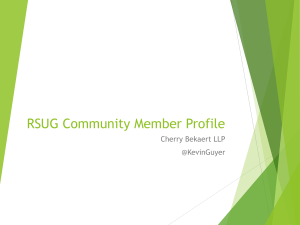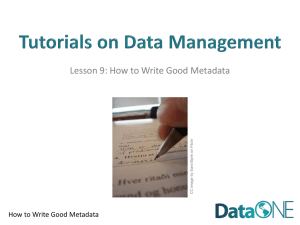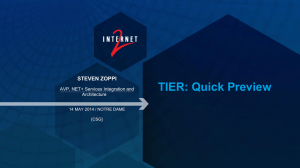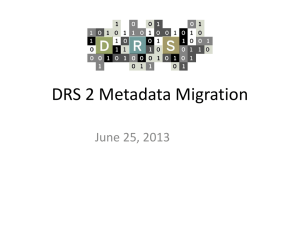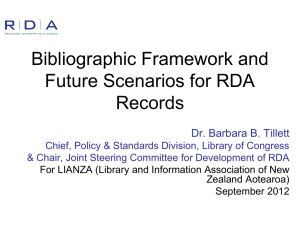Building Metadata Application Profiles/2
advertisement
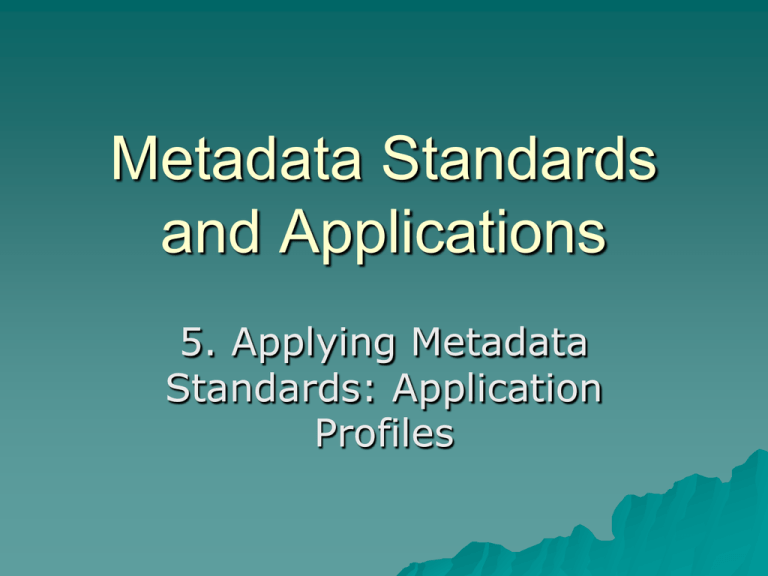
Metadata Standards and Applications 5. Applying Metadata Standards: Application Profiles Goals of Session Learn how metadata standards are applied, used and documented: Learn about the concept and use of application profiles Explore how different metadata standards may be used together in digital library applications Metadata Standards & Applications 2 Why Application Profiles? Describes the set of metadata elements, policies, guidelines and vocabularies defined for a particular domain, implementation, or object type – Declares the metadata terms an organization, information resource, application, or community uses in its metadata – Documents metadata standards used in instance data, including schemas and vocabularies, policies, required elements, etc. – Called “application profile” or just “profile” Metadata Standards & Applications 3 Benefits of Documenting Terms We Use To provide authoritative specification of term usage To facilitate interoperability by informing potential users of domain consensus To support evolution of vocabularies To encourage alignment of practice To enable interpretation of legacy metadata Metadata Standards & Applications 4 Less Flexibility, More Predictability Many metadata standards are sufficiently flexible that they need a mechanism to impose some constraints – Profiles allow expression of the decisions made for a project in machine-readable form (XML or RDF) Refining – Allow a narrower interpretation of a standard to suit your project Combining – Enable mixing elements from various different standards (there are limits to this!) Metadata Standards & Applications 5 Components of an AP Human readable documentation – Property descriptions and relationships – Domain or project specific instruction – Obligation and constraints Machine-readable versions may contain: – Specific encoding decisions and XML or RDF schemas – Models of data relationships specific to the AP represented in the schemas – Functional requirements and use cases supporting decisions Metadata Standards & Applications 6 Using Properties from other Schemas DC APs set stringent requirements for determining reusability of terms: – Is the term a real “property” and defined as such within the source schema? – Is the term declared properly, with a URI and adequate documentation and support? – In general, properties whose meaning is partly or wholly determined by its place in a hierarchy are not appropriate for reuse in DC APs without reference to the hierarchy. Other styles of profiles have different requirements and strategies for developing machine-readability and validation Metadata Standards & Applications 7 Documenting new properties Minimum: a web page, with the relevant information available to other implementations Better: a web page and an accessible schema using your terms as part of your application profile Best: all terms available on a distributed registry Metadata Standards & Applications 8 Singapore Framework A Framework for designing metadata applications for maximum interoperability – Defines a set of descriptive components that arenecessary for documenting an Application Profile – Forms a basis for reviewing Dublin Core application profiles – Relates APs to standard domain models and Semantic Web standards – http://dublincore.org/documents/singaporeframework/ Metadata Standards & Applications 9 An RDA Application Profile A DCMI/RDA Task Group has been defining RDA properties and value vocabularies as formal RDF vocabularies (with URIs) – IFLA has stated an intention to declare FRBR entities and attributes as well – Next step is a DC application profile of RDA according to the Singapore Framework – See http://metadataregistry.org for the provisionally registered properties/vocabularies Metadata Standards & Applications 10 METS Profiles Description of a class of METS documents provides document authors and programmers guidance to create and process conformant METS documents – XML document using a schema – Expresses the requirements that a METS document must satisfy METS Profiles are output in humanreadable prose and not intended to be “machine actionable” (but they use a standard XML schema) Metadata Standards & Applications 11 Components of a METS Profile 1. Unique URI 2. Short Title 3. Abstract 4. Date and time of creation 5. Contact Information 6. Related profiles 7. Extension schemas 8. Rules of description 9. Controlled vocabularies 10. Structural requirements 11. Technical requirements 12. Tools and applications 13. Sample document Metadata Standards & Applications 12 MODS Profiles Some applications are establishing MODS profiles to document usage, required elements, controlled vocabularies used, etc. Some examples: – DLF Aquifer MODS profile: to establish implementation guidelines for rich shared metadata for cultural heritage materials – British Library electronic journal MODS profile Metadata Standards & Applications 13 METS & MODS Together METS can be used to package together the metadata with the objects – METS allows for use of any XML metadata schema in its extensions – MODS can be associated with any level of the description – Technical metadata can be inserted and associated with specific files Metadata Standards & Applications 14 Summary Thoughts on APs Many metadata standards are sufficiently flexible that profiling is necessary – Documenting what is used in an application will simplify and enhance data presentation, conversion from other sources, ability to provide different outputs – Constraining a metadata standard by specifying what is used and how facilitates data exchange and general interoperability Documentation is always a good value! Metadata Standards & Applications 15 DC Application Profile Examples Collections AP – http://www.dublincore.org/groups/collections/ collection-application-profile/2007-03-09/ Scholarly Works Application Profile (SWAP) – http://www.ukoln.ac.uk/repositories/digirep/in dex/Eprints_Application_Profile Both these have been reviewed by the DC Usage Board and are deemed compliant with the DC Abstract Model Metadata Standards & Applications 16 METS/MODS AP Examples University of Maryland Descriptive Metadata – http://www.lib.umd.edu/dcr/publications/taglib rary/umdm.html UVa DescMeta – http://lib.virginia.edu/digital/metadata/descrip tive.html Texas Digital Library profile for electronic theses and dissertations – http://metalogger.files.wordpress.com/2007/0 6/tdl-etd-mods-profile.pdf Metadata Standards & Applications 17 Vocabulary Development in an AP: a Case Study of KMODDL http://kmoddl.library.cornell.edu/aboutme ta2.php Needed to describe all kinematic models, plus materials related to the models Developed several special vocabularies: – Voigt1 and Voigt2 (plus the IDs) – KMODDL Type (plus ID) – An AAT subset for Medium Adapted: – DLESE GradeRange for Audience – MARC Organization List for MODS:physicalLocation Metadata Standards & Applications 18 Voigt1 and Voigt2 Based on a 19th century treatise on the Reuleaux models, which classified them based on mechanical principles (http://kmoddl.library.cornell.edu/model.php) Names of the mechanisms used as subject terms Classification numbers used as IDs to tie the related materials together Metadata Standards & Applications 19 KMODDL Type Vocabulary http://kmoddl.library.cornell.edu/aboutmeta3.php Used to differentiate a complex array of versions and related materials from one another Allows distinctions between print and digital (of the same resources) and identifies granular levels within those resources Enables creation of organized web pages presenting the information to users Metadata Standards & Applications 20 KMODDL Example http://kmoddl.library.cornell.edu/mo del.php?m=244 Note: – Browse tree tab on left – Lists of linked References and Resources at the bottom of the page – Attributed description – Tabs for Image and Movie on the top right Metadata Standards & Applications 21 Exercise Critique an Application Profile for a community or project, e.g., the Open Language Archives Community Metadata Set (OLAC-MS) – OLAC Metadata (DC-based) http://www.languagearchives.org/OLAC/metadata.html – University of Maryland Descriptive Metadata http://www.lib.umd.edu/dcr/publications/taglib rary/umdm.html – UVa DescMeta http://lib.virginia.edu/digital/metadata/descrip tive.html Metadata Standards & Applications 22 Exercise: Questions to address Does the profile define its user community and expected uses? How usable would the profile be for a potential implementer? How (well) does the profile specify term usage? How (well) does the profile define and manage vocabularies? Are there key anomalies, omissions, or implementation concerns? Metadata Standards & Applications 23



